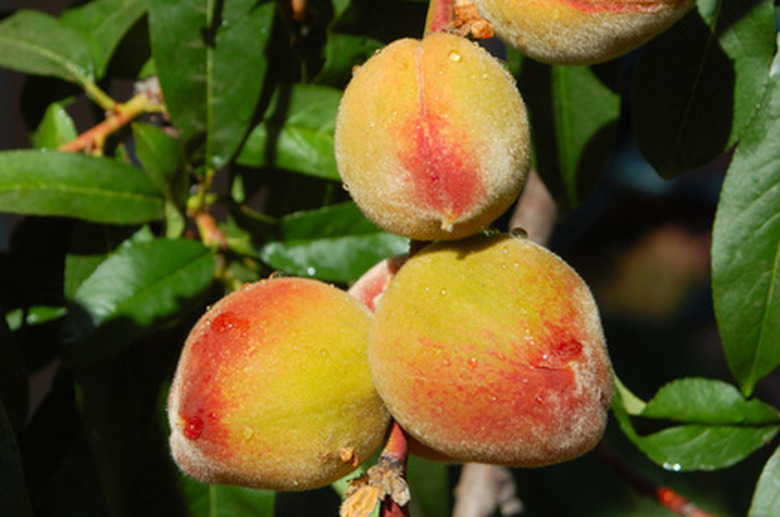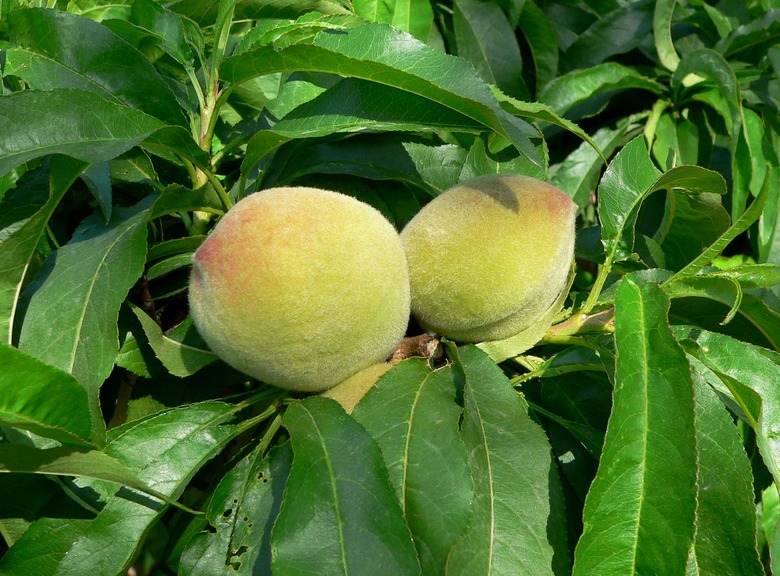Dwarf Peach Trees: Facts, Cultivars And Growing Information
Peaches (Prunus persica) are a popular type of stone fruit. However, standard-size trees, which can grow to heights of up to 25 feet, can be difficult to maintain in a home garden. Dwarf peach trees produce full-size peaches, just like standard-size trees; however, their smaller height makes caring for the trees and harvesting the fruit easier.
Most peach trees can survive winters in USDA hardiness zones 5 to 9, though certain factors can affect the hardiness of dwarf fruit trees.
Dwarf Peach Trees
Some peach trees are genetic dwarves, which means they are naturally small peach trees. However, "dwarf peach tree" or "semi-dwarf peach tree" can also refer to a standard-size peach cultivar that has been grafted, or attached to, a dwarf rootstock to maintain a smaller size. These trees are generally not considered winter hardy and are therefore not recommended for many colder climates. Rootstock can also affect a peach tree's disease resistance.
Most peach trees are self-fertile, which means they can set fruit with their own pollen and do not require cross-pollination. In other words, only one tree is needed to produce fruit.
If you start with a tree that is 1 or 2 years old, **you can expect it to bear fruit within two to five years after planting.**
Tip
Some "dwarf" or "semi-dwarf" peach trees are actually just standard-size peach cultivars that have been grafted, or attached to, a dwarf rootstock to maintain a smaller size. These trees are generally not considered winter hardy and are therefore not recommended for many colder climates.
Dwarf Peach Cultivars
**Bonanza:** If you are looking to plant a dwarf peach tree that produces flavorful fruit, a good option is Bonanza (Prunus persica 'Bonanza'; zones 6 through 9), a genetic dwarf that reaches maximum heights between 5 and 6 feet. The fruit of the Bonanza may have red or orange skin, while its yellow flesh is sweet. This miniature peach tree can be grown in a large container.
**Reliance:** One of the hardiest peach cultivars available, Reliance (Prunus persica 'Reliance'; zones 5 to 8) may be grafted onto dwarf rootstock, resulting in a tree that is about 8 to 10 feet tall. When grafted onto standard-size rootstock, Reliance can reach heights between 12 and 15 feet. Reliance peaches, which have yellow skin, are freestone, meaning the seed inside is not attached to the flesh.
All fruit trees, including peach trees, require a certain number of "chill hours"—hours of exposure to temperatures between 32 and 45°F—to break dormancy and flower. The number of chill hours depends on the peach cultivar. Reliance, for example, requires 1,000 chill hours, which is considered high. Fewer than 500 hours is a low chill requirement.
How to Grow Dwarf Peach Cultivars
- **Soil and Watering Needs:** Peach trees, regardless of size or cultivar, grow best in soil that has a pH of 6.5. Choose a site with well-draining soil where your tree will receive at least 8 hours of full sun a day. Make sure to provide consistent moisture, but do not overwater peach trees, as this can lead to a condition known as root rot.
- **Fertilizer:** Peach trees benefit from a balanced fertilizer application in the spring and again in the fall. Compost can provide most of the nitrogen these trees need.
- **Thinning Fruit:** Most peach trees produce more fruit than their branches can hold. Therefore, you'll want to thin fruit to leave just one to three per fruiting branch. You can remove unwanted fruit by hand.
- **Pest Management:** Peach trees are susceptible to infestations by many types of pests, including from a destructive moth known as the peach tree borer. You may need to apply a peach-tree-approved insecticide starting in late May or
early June. You can also manually eliminate them by inserting a thin flexible wire into the holes made by the borers.
References
- University of Missouri Extension: Home Fruit Production – Peach and Nectarine Culture
- University of New Hampshire Cooperative Extension: Growing Peaches and Nectarines in the Home Garden
- Missouri Botanical Garden: Prunus persica 'Bonanza'
- Missouri Botanical Garden: Prunus persica 'Reliance'
- University of Minnesota Extension: Growing stone fruits in the home garden
- University of Connecticut Home and Garden Education Center: Peaches and Nectarines
- Utah State University Extension: Peaches in the Garden
- UCCE Master Gardeners of Orange County – Edible Plants – Peach, Growing

